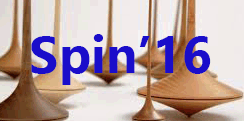Conveners
Poster: Poster Session
- Caroline Kathrin Riedl (Univ. Illinois at Urbana-Champaign (US))
Description
Appetizers will be served. A beer and wine cash bar will be open.
Please hand your poster to the organizers on Wednesday afternoon. It will be prepared for your presentation on poster walls during the tour to Blue Waters, which you thus can join.
Formats: Landscape / horizontal preferred. Vertical is probably OK except if it is an extreme aspect ratio.
The E-906/SeaQuest experiment has a new event reconstruction program available which will be used to perform future experiment analyses and cross-check various existing results. The focus of this poster will be on a dimuon mass spectrum and tracker efficiency study conducted with SQERP, focusing on dimuons produced via the Drell-Yan process. A mass spectrum study will isolate processes that...
The role of the anomalous moment in the geometric Clifford algebra of proton topological mass generation suggests that the anomaly is not an intrinsic property of the free space proton, but rather a topological effect of applying the electromagnetic bias field required to define the eigenstates probed by the magnetic moment measurement [1]. Quantum Interpretations try to explain emergence of the...
The longitudinal double-spin asymmetry (ALL) is spin-polarized p+p collisions provides insight into the gluon contribution to the proton’s spin by accessing the gluon helicity distribution ∆g. The PHENIX π0 and STAR jet ALL measurement show a non-zero asymmetries and hence indicate a nonzero ∆g in an NLO analysis. The STAR measurements of jet A LL in √s = 200 and 510 GeV polarized p+p...
One of the primary goals of the STAR spin program is to determine the spin-dependent gluon distribution, ∆G, of the proton. Recent measurements of the longitudinal double-helicity asymmetry, ALL, from inclusive jets place strong constraints on ∆G and, for the first time, find evidence for non-zero gluon polarization values for partonic momentum fraction x greater than 0.05. In contrast to...
The spin structure of the proton is of extreme complexity and remains one of the unresolved physics problems. The STAR experiment, located at the Relativistic Heavy Ion Collider (RHIC) at Brookhaven National Laboratory (BNL), is performing a wide range of measurements to deconstruct the partonic contributions to the spin of the proton by analyzing polarized pp collisions. The Sivers effect...
We consider a 1+1 dimensional model for nuclei where the ‘nucleons’ are represented by a heavy-light system. This allows for the study of binding energies and quark distributions as a function of the separation between the nucleons. We find a significant shift of quark distributions towards smaller momentum.
Transverse single-spin asymmetries provide valuable information on the spin structure of the nucleon. At RHIC energies, heavy flavor production is dominated by gluon-gluon fusion, and the transverse single-spin asymmetry is sensitive to the tri-gluon correlations in the twist-3 collinear factorization. Study of this asymmetry for single muons from heavy flavor decays in the PHENIX experiment...
The COMPASS spectrometer at CERN took data in 2015 from a 190 GeV pion beam impinged on a vertically polarized proton target. The proton target consisted of two cells oppositely polarized with the polarization switched after each week. The goal of the 2015 COMPASS Drell-Yan data taking is to measure the Sivers amplitude from single spin asymmetries and therefore be able to determine a sign...
